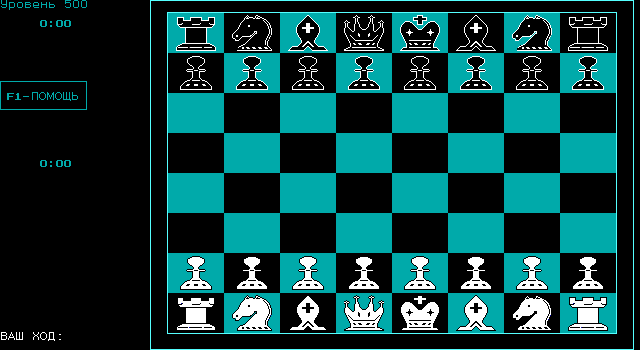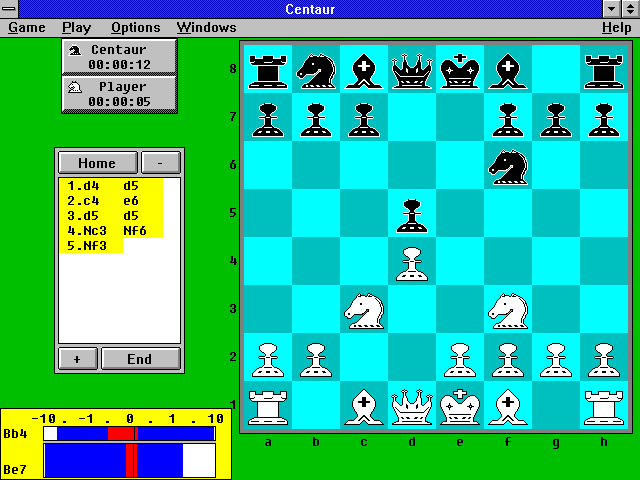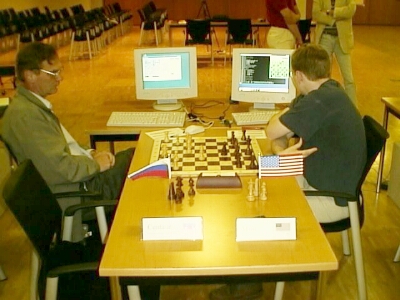Centaur
Centaur (Russian: Кентавр),
a chess program by primary author Victor Vikhrev and Alexey Manjakhin. Its development already started in 1971, when Victor Vikhrev wrote his first chess program in Algol for the BESM-6. During the 80s the program was re-written in Pascal to run on an IBM PC [2] [3]. As one of the rare instances of a best-first searcher, Centaur keeps its complete search tree in memory considering multiple optimistic, realistic and pessimistic evaluation scores, and to grow the tree based on the probability distribution of those scores, it seems quite similar to Palay's PB* [4] [5]. A DOS version of Centaur featuring a 3D graphics board was released in the early 90s, a 16-bit Windows 3.x version was commercially available since the mid 90s [6].
Contents
Tournament Play
Centaur won the First Soviet Computer-Chess Championship 1988 in Ulan-Ude, and further competed at the First International Chess-Computer Tournament in the USSR 1989 in Moscow, at three World Computer Chess Championships, the WCCC 1989 in Edmonton, the WCCC 1992 in Madrid, and the WCCC 1999 in Paderborn, four World Microcomputer Chess Championships (WMCCC 1991, WMCCC 1993, WMCCC 1995, WMCCC 1996) [7], two Uniform-Platform Computer Chess Championships (UPCCC 1993, UPCCC 1994), and three Aegon Man-Machine Tournaments (Aegon 1995, Aegon 1996, Aegon 1997).
Dragon
Centaur, along with some code units incorporated from Mirage by Vladimir Rybinkin and Yuri Shpeer, further evolved to the Dragon analysis engine of Convekta's Chess Assistant database [8], not to confused with the original Dragon engine by Yuri Shpeer [9].
Screenshots
DOS
Centaur for DOS
Windows
Centaur for Windows 3.x [10]
Photos & Games
WCCC 1999: Centaur vs. Mini, Victor Vikhrev and Harald Prokop
[Event "WCCC 1999"] [Site "Paderborn, Germany"] [Date "1999.06.19"] [Round "7"] [White "Centaur"] [Black "Mini"] [Result "0-1"] 1.e4 e5 2.Nf3 Nf6 3.Nxe5 d6 4.Nf3 Nxe4 5.d4 d5 6.Bd3 Nc6 7.O-O Be7 8.Re1 Bg4 9.c4 Nf6 10.cxd5 Bxf3 11.Qxf3 Qxd5 12.Qxd5 Nxd5 13.Nc3 Ndb4 14.Be4 Nxd4 15.Bf4 Ne6 16.a3 Nd3 17.Bxd3 Nxf4 18.Bf5 Kf8 19.Rad1 g6 20.Be4 Ne6 21.Bd5 Nd8 22.Re2 c6 23.Bc4 b5 24.Bb3 f5 25.Rd7 Bf6 26.a4 a6 27.h3 Rb8 28.Red2 Bg5 29.f4 Bf6 30.axb5 axb5 31.Kh2 Ke8 32.Rc7 h5 33.Rd6 Rf8 34.Nd1 Rb6 35.g3 Rb8 36.Rh7 c5 37.Bd5 c4 38.Rh6 Ke7 39.Ra6 Rc8 40.Rxg6 h4 41.gxh4 Rc5 42.Ra7+ Kd6 43.Bg2 Ne6 44.Kg3 b4 45.Ne3 c3 46.Ra6+ Kd7 47.Bd5 Nc7 48.Rgxf6 Rxf6 49.Rxf6 Nxd5 50.bxc3 Nxf6 51.cxb4 Rc3 52.Kf2 Ke6 53.b5 Rb3 54.Nc4 Nh5 55.Nd2 Rxb5 56.Nf3 Rb2+ 57.Ke3 Rb3+ 58.Kf2 Kd5 59.Ng5 Nxf4 60.Nf3 Nxh3+ 61.Ke2 f4 62.Nd2 Re3+ 63.Kd1 Nf2+ 64.Kc1 Ne4 65.h5 Re1+ 66.Kb2 Re2 67.Kb3 Nxd2+ 68.Kb2 Kc4 69.h6 Nb3+ 70.Ka3 Nc1 71.Ka4 0-1
Descriptions
1989
based on the WCCC 1989 booklet [11] :
Centauer is a new chess-playing program with the heuristic search to consider the decisive series of moves. The algorithms is based on the probability logic and uses a fuzzy value of positions. The depth of the search is not limited. The whole information about all the series of moves is kept in RAM and is used to determine the decisive series of moves. Centaur features a low number of position analyzed. This is compensated with thoroughness of the position evaluation.
1991
from Don Beal's WMCCC 1991 report [12] :
Centaur is the outstanding exception in the current pattern. It uses a much more human like approach, and despite its eventual losses, actually played well most of the time. For instance, it had a draw against Gideon for a long time, only going astray in the endgame. Written by Victor Vikhrev and Alexey Manjakhin, and winner of the first Moscow computer-chess tournament, this program is highly unconventional, and does not use alpha-beta, iterative search. Instead, it grows a selective tree, kept fully in memory, on a best-first basis. Position evaluation is not reduced to one number - instead a vector of values is produced from which 3 optimistic and 3 pessimistic evaluations are made under different assumptions. These 6 values determine a probability distribution of results for a position, which is used to guide tree growth and ultimately to choose a move. Victor Vikhrev describes his approach as intermediate between conventional programs and the even more selective approach of Botvinnik's program, Pioneer.
1993
from Don Beal's UPCCC 1993 report [13] [14] :
Written by Victor Vikrev, a nuclear physicist in Moscow, as a major hobby over the past 30 years, plus Alexei Manjakhin. It is remarkable for being very different in design from all the other programs that do well in championships. It explores only a few future positions (instead of millions), but analyses them in more detail. In this respect its thinking is more human-like than any other program. It scored 2 from 5 in the last "unlimited machine" championship, and placed 17.
1999
Centaur is a highly selective program, originated from Kurchatov Institute in Moscow. It is a completely unique program. Despite the lighting speed of its hardware it only examines about 500 positions per second. Centaur has a rating of 2,266 at AEGON97.
Centaur uses 5 values for estimation of chess position (one realistic, two pessimistic and two optimistic). All 5 values of a position are saved in memory of computer and are used for choice of direction of investigation of position.
Last modification of Centaur uses some code units from program Mirage, which is made in Russia. Principles of Centaur are described in ICCA Journal 1996, 2 [16]
See also
Publications
- Victor Vikhrev (1996). The Choice of a Research Direction. ICCA Journal, Vol. 19, No. 2
Forum Posts
1993 ...
- QMW computer chess by Don Beal, rec.games.chess, August 19, 1993 » UPCCC 1993
- Re: What is Centaur's strength? by Bruce Moreland, rgcc, November 26, 1996
- Most entertaining game in round 1? My vote is Centaur-Fritz by Peter Kappler, CCC, June 15, 1999
2000 ...
- About "Centaur" by Fernando Villegas, CCC, January 05, 2000
- Centaur Impressions and a bit more -or less... by Fernando Villegas, CCC, January 05, 2000
- Re: What is Engine Centaur on Fritz7 Server (long version) by Mike S., CCC, December 04, 2001
- Заставить работать машину клиента! Конференция by Vladimir Rybinkin, Конференция iXBT.com, September 01, 2009
2010 ...
- Re: La Máquina Preservadora. Programas de Ajedrez by Tibono, Meca Foro, October 09, 2015 (Spanish)
- Centaur by Fernando, Hiarcs Forum, March 16, 2017
External Links
Chess Program
- Centaur's ICGA Tournaments
- ChessPro online | Шахматный форум | Новости мира движков (Russian)
- Free Chess Downloads by Ed Schröder
Misc
- Advanced Chess from Wikipedia (Centaur chess)
- Centaur (disambiguation) from Wikipedia
- Centaur from Wikipedia (Greek mythology)
References
- ↑ The front page of Jugend magazine 1910, Vol. 15, featured this illustration by Heinrich Kley, Wikimedia Commons, source: Jugend: Münchner illustrierte Wochenschrift für Kunst und Leben (15.1910, Band 1 (Nr. 1-26)) from Heidelberg University Library: Heidelberg historic literature – digitized
- ↑ http://adamant1.fromru.com/centaur.html Кентавр (Russian, as of October 2018 no longer available)
- ↑ ChessPro online | Шахматный форум | Новости мира движков (Russian)
- ↑ Andrew James Palay (1983). Searching with Probabilities. Ph.D. thesis, Carnegie Mellon University, pdf
- ↑ Hans Berliner, Chris McConnell (1995). B* Probability Based Search. Carnegie Mellon University Computer Science research report
- ↑ Re: La Máquina Preservadora. Programas de Ajedrez by Tibono, Meca Foro, October 09, 2015 (Spanish)
- ↑ Centaur's ICGA Tournaments
- ↑ Chess Assistant - ChessOK
- ↑ Заставить работать машину клиента! Конференция by Vladimir Rybinkin, Конференция iXBT.com, September 01, 2009
- ↑ Septober - Computerschach by Herbert Marquardt
- ↑ Kings Move - Welcome to the 1989 AGT World Computer Chess Championship. Edmonton, Alberta, Canada, Courtesy of Peter Jennings, from The Computer History Museum, pdf
- ↑ Don Beal (1991). Report on the 11th World Microcomputer Chess Championship. ICCA Journal, Vol. 14, No. 2
- ↑ Don Beal (1993). Report on the QMW 1993 Uniform-Platform Computer-Chess Championship. ICCA Journal, Vol. 16, No. 3
- ↑ QMW computer chess by Don Beal, rec.games.chess, August 19, 1993
- ↑ Centaur's ICGA Tournaments
- ↑ Victor Vikhrev (1996). The Choice of a Research Direction. ICCA Journal, Vol. 19, No. 2



